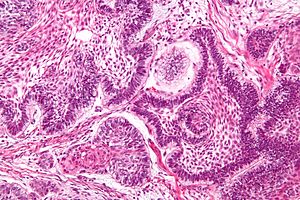Ameloblastoma
Jump to navigation
Jump to search
The printable version is no longer supported and may have rendering errors. Please update your browser bookmarks and please use the default browser print function instead.
| Ameloblastoma | |
|---|---|
| Diagnosis in short | |
 Ameloblastoma. H&E stain. | |
|
| |
| LM | stellate reticulum (star-shaped cells), tall columnar cells that have palisaded nuclei with reverse polarization, subnuclear vacuolization, +/-giant cells, +/-subepithelial hyalinization (eosinophilic acellular amorphous material) |
| Subtypes | solid/multicystic, unicystic |
| LM DDx | adenomatoid odontogenic tumour, ameloblastic fibroma |
| Site | usu. mandible - see odontogenic tumours and cysts |
|
| |
| Prevalence | uncommon |
| Prognosis | locally aggresive, rarely malignant |
| Clin. DDx | keratocystic odontogenic tumour, odontogenic cysts |
Ameloblastoma is an odontogenic tumour.
General
- Osteous lesion.
- Usually mandible.[1]
- May arise from an odontogenic cyst,[3] e.g. dentigerous cyst.[4]
- Can be malignant[5] - rare.[6]
Classification
Location:
- Intra-osseous.
- Locally aggressive.
- Peripheral.
- Benign.
Subclassification of intra-osseous type
Histology:
- Solid/multicystic.
- More commonly reoccur.
- Unicystic.
- Unlikely to reoccur.
- Classically found in younger individuals.
Gross
- Mass - usu. mandible or maxilla.[6]
- Mandile most common.
Microscopic
Features:[7]
- Stellate reticulum - star-shaped cells, found in a developing tooth.
- Tall columnar cells.
- Palisaded nuclei with reverse polarization.
- Reverse polarization of nuclei = nuclei distant from the basement membrane/nuclei at pole opposite of basement membrane.
- Palisaded nuclei = picket fence appearance; columnar-shaped nuclei with long axis perpendicular to the basement membrane -- key feature.
- Subnuclear vacuolization.
- Palisaded nuclei with reverse polarization.
- +/-Giant cells.
- +/-Subepithelial hyalinization (eosinophilic acellular amorphous material).
- Seen deep to the basement membrane.
- Variable morphology (see below - morphology).
DDx (nuclear palisading):
Images
Morphology
- Not prognostic.
Morphologic variants:
- Follicular ameloblastoma (classic appearance).
- Plexiform ameloblastoma (does not have prominent palisading).
- Acanthomatous ameloblastoma.
- Desmoplastic ameloblastoma.
- Basaloid ameloblastoma.
See also
References
- ↑ URL: http://www.waent.org/archives/2010/Vol3-2/20100618-ameloblastoma/jaw-tumor.htm. Accessed on: 30 November 2011.
- ↑ Reichart, PA.; Philipsen, HP.; Sonner, S. (Mar 1995). "Ameloblastoma: biological profile of 3677 cases.". Eur J Cancer B Oral Oncol 31B (2): 86-99. PMID 7633291.
- ↑ Eversole, LR. (Nov 1999). "Malignant epithelial odontogenic tumors.". Semin Diagn Pathol 16 (4): 317-24. PMID 10587275.
- ↑ Moosvi, Z.; Tayaar, SA.; Kumar, GS. (Apr 2011). "Neoplastic potential of odontogenic cysts.". Contemp Clin Dent 2 (2): 106-9. doi:10.4103/0976-237X.83073. PMC 3180832. PMID 21957386. https://www.ncbi.nlm.nih.gov/pmc/articles/PMC3180832/.
- ↑ Goldenberg, D.; Sciubba, J.; Koch, W.; Tufano, RP. (Oct 2004). "Malignant odontogenic tumors: a 22-year experience.". Laryngoscope 114 (10): 1770-4. doi:10.1097/00005537-200410000-00018. PMID 15454770.
- ↑ 6.0 6.1 Chou, YH.; Jhuang, JY.; Chang, MH.; Huang, WC.; Hsieh, MS. (Jun 2013). "Metastasizing Ameloblastoma With Localized Interstitial Spread in the Lung: Report of Two Cases.". Int J Surg Pathol. doi:10.1177/1066896913491321. PMID 23775022.
- ↑ URL: http://www.pathconsultddx.com/pathCon/diagnosis?pii=S1559-8675%2806%2970616-7. Accessed on: March 9, 2010.



